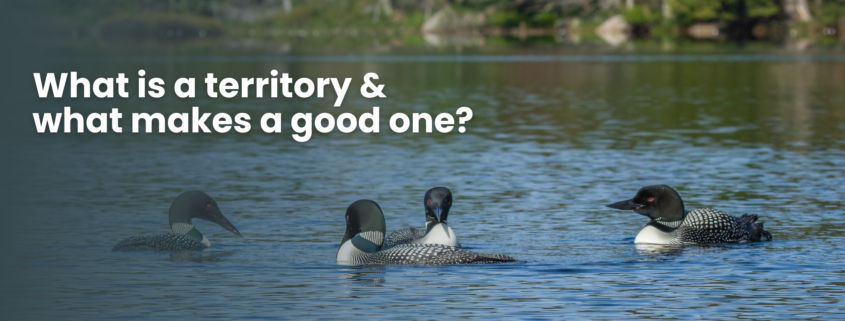What is a territory & what makes a good one?
Loons are migratory birds that typically spend the winter on the ocean and breed on lakes and ponds in northern North America. During the breeding season, loons are highly territorial and will defend their breeding territory from other loons. Throughout the breeding season, you may see loons engaging in fights as they battle for control of breeding territories. Having a good territory (and knowledge of that territory) is important for breeding success. But what exactly is a territory, and what makes a good one?
A territory is a specific area of water that a pair of loons occupy and defend from other members of their species. In New Hampshire, several characteristics have been identified that make lakes more likely to be occupied by loons. These characteristics include lake size, water clarity, and the presence of islands, amongst other things.
A general rule of thumb is that a lake needs to be 50 or more acres in size to support a loon pair and chicks. However, it is important to note that there are some exceptions to this in New Hampshire—we have breeding loons on a small number of lakes that are 20-30 acres in size. Some lakes that are a couple hundred acres or more may be able to support more than one pair of loons. New Hampshire’s largest lake, Lake Winnipesaukee, had 32 resident loon pairs in 2022.
Water quality has also shown to be an important predictor of loon occupancy on lakes. As visual predators, loons tend to prefer clear-water lakes where it is easier to locate and pursue prey to support themselves and their chicks. A good territory will also have plenty of prey items (fish and aquatic invertebrates) for loons to eat and feed to their young.
Another important feature of a good loon territory is the presence of potential sites for nesting. Loons often nest on the lee side of small islands, and lakes with islands are more likely to have resident loons. A good territory will often include multiple potential nesting sites. Ideally, nesting sites will be protected from strong winds and waves. Good loon territories often also have protected areas, such as coves, for loons to brood their chicks in once they hatch. Though loon families often range over the entire lake, they may more often stick to these protected areas when chicks are young and more vulnerable.
A successful breeding territory is worth fighting for, and loons can and do fight hard over territories. The members of the pair that are occupying a given territory will fight to maintain their control of it, and loons that do not yet have an established territory of their own (known as ‘intruding’ loons) may acquire a territory by fighting to take-over an already occupied territory. In a territorial take over, the intruding loon enters an occupied territory and challenges the member of the pair that is the same sex. If the intruder wins the fight, it will evict the territory holder and take its place as the member of the breeding pair on that territory. Research from Wisconsin showed that in their study area, 41.5% of territory acquisitions happened through take-over (defined as either evicting a pair member from a defended territory or appropriating a territory before the seasonal return of its’ previous owners).
In his necropsies of New England loons, Dr. Mark Pokras found that nearly half (46%) of the loons that examined at Tufts Wildlife Clinic from 2007–2015 had puncture wounds in their sternums. These punctures were made by the bills of other loons, and their presence on a given loon’s sternum is evidence that the loon has fought hard with other loons at some point in its life, likely over control of a territory. However, many loons are able to heal from these injuries—in New Hampshire, just 6% of necropsied loons from 1989–2022 were found to have been killed by another loon. The leading cause of loon mortality in the state is lead poisoning resulting from the ingestion of lead fishing tackle, which has accounted for 39% of adult loon deaths in that same timeframe.



